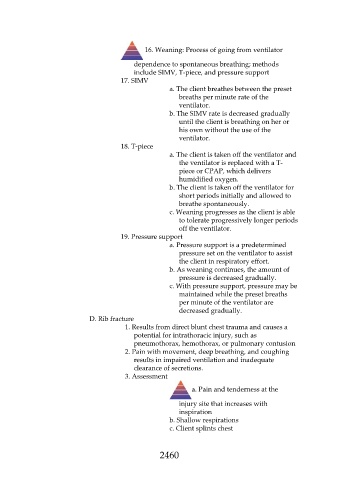Page 2460 - Saunders Comprehensive Review For NCLEX-RN
P. 2460
16. Weaning: Process of going from ventilator
dependence to spontaneous breathing; methods
include SIMV, T-piece, and pressure support
17. SIMV
a. The client breathes between the preset
breaths per minute rate of the
ventilator.
b. The SIMV rate is decreased gradually
until the client is breathing on her or
his own without the use of the
ventilator.
18. T-piece
a. The client is taken off the ventilator and
the ventilator is replaced with a T-
piece or CPAP, which delivers
humidified oxygen.
b. The client is taken off the ventilator for
short periods initially and allowed to
breathe spontaneously.
c. Weaning progresses as the client is able
to tolerate progressively longer periods
off the ventilator.
19. Pressure support
a. Pressure support is a predetermined
pressure set on the ventilator to assist
the client in respiratory effort.
b. As weaning continues, the amount of
pressure is decreased gradually.
c. With pressure support, pressure may be
maintained while the preset breaths
per minute of the ventilator are
decreased gradually.
D. Rib fracture
1. Results from direct blunt chest trauma and causes a
potential for intrathoracic injury, such as
pneumothorax, hemothorax, or pulmonary contusion
2. Pain with movement, deep breathing, and coughing
results in impaired ventilation and inadequate
clearance of secretions.
3. Assessment
a. Pain and tenderness at the
injury site that increases with
inspiration
b. Shallow respirations
c. Client splints chest
2460

